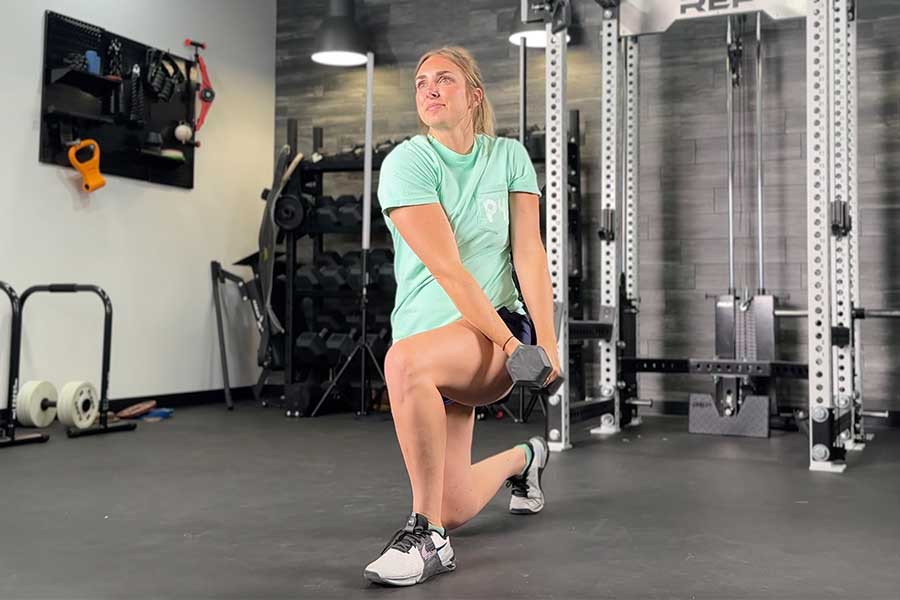We test and review fitness products based on an independent, multi-point methodology. If you use our links to purchase something, we may earn a commission. Read our disclosures.
The wood chop exercise is a weighted rotational movement performed with various equipment and angles. Your body is a three-dimensional machine, with rotation being one of those movements. The problem is many exercisers need to pay more attention to this movement and leave potential core strength gains on the table.
RELATED: Best Core Exercises Equipment
But after performing the wood chop exercise, you’ll also be a rotational machine with improved core strength and the ability to chop wood like a logger. All you need to do is sharpen your ax.
Anyhow, the beauty of the dumbbell wood chop exercise trains multiple muscles from your hips, core, and shoulders, making it more than just a core exercise. Not only is rotating the hips and torso together great for rotational sports like golf and baseball, but for activities of daily living like shoveling, swinging an ax, or lifting a baby in and out of a car.
Here we’ll get into everything wood chop so you can confidently include it in your core workout.
How To Do the Dumbbell Wood Chop Exercise
Here is a step-by-step guide on proper dumbbell wood chop form. You can also perform this move standing for more of a full-body workout.
- Kneel on one leg with your other leg at a 90-degree angle in front of you. Hold a dumbbell in front of you with both hands with your arms extended.
- Bring the dumbbell up across your body and over your shoulder with your elbows slightly bent, rotating your torso while keeping your lower body straight.
- Repeat continuously for the desired repetitions.
- Do all your reps on one side and then repeat on the other side.
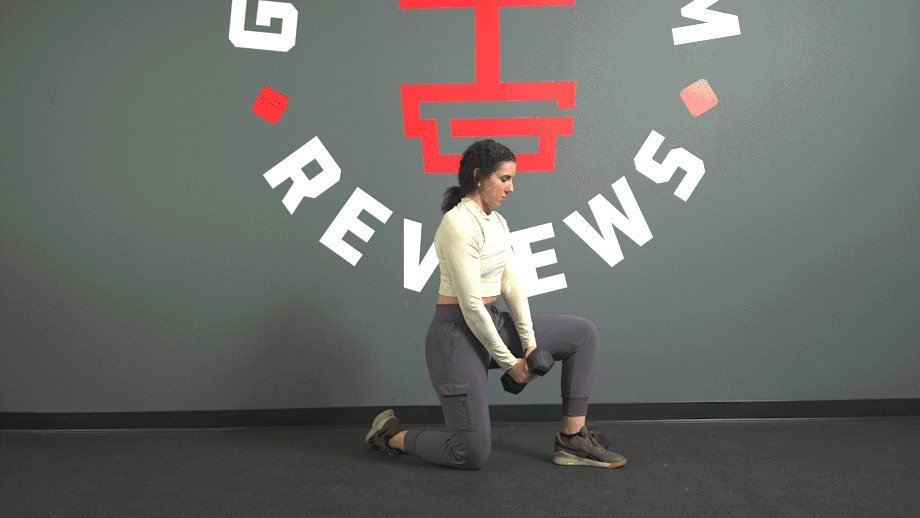
Dumbbell Wood Chop Form Tips
Pay attention to these form tips from a certified personal trainer to ensure proper form for the dumbbell wood chop.
- There are two ways you can hold the dumbbell. Hold either end on the dumbbell or interlock both hands around the dumbbell handle. The way you grip it is a matter of personal preference.
- The wood chop exercise is a full-body coordinated movement that involves the lower and upper body. So, if you’re a beginner or new to the movement, perform slowly to ensure better form. When you have got it down, you can perform it quicker.
- Pause and reset at the end of each rep to ensure you use only a little momentum to perform this movement.
4 Wood Chop Benefits
The core muscles work best together, like with the dumbbell woodchopper, as one and not as individual parts. The wood chop exercise is a full-body movement that involves the lower and upper body, and the core works as a bridge between the two. This makes a wood chop a must for your abs workout.
Functional Movement
So many movements, activities, and sports involve rotating the hips, core, and torso. So it pays to train this to reduce injuries, improve performance, and make your daily activities that involve rotation easier.
Total-Body Workout
Full body exercises like the dumbbell wood chop exercise train more muscle, burn more calories to help burn belly fat, and train the core as a unit for more functionality on the sporting field and in your everyday activities.
Improved Anti-Rotational Strength
Developing stronger obliques in the rotational plane with the wood chop exercise can improve your ability to stabilize the spine and hips during explosive movements such as kettlebell swings, med ball slams, and even the Olympic lifts.
RELATED: Medicine Ball Workouts
Better Sports Performance
Strengthening the core with rotational exercises like the dumbbell wood chop can help athletes1 integrate the hips and upper torso into rotational movements, like throwing a football or baseball or swinging a golf club.
Muscles Worked by Wood Chop
Here are the primary muscles worked with the wood chop exercise:
Shoulders
Your shoulder muscles play a few vital roles during the wood chop exercise. Your shoulder stabilizer muscles, like the rotator cuff, ensure the scapula does its job while your arms move. Taking the dumbbell above your shoulder trains all three deltoid muscles through shoulder flexion and horizontal abduction.
Glutes
Your glutes function as stabilizers and extenders during eccentric and concentric muscle contraction. The smaller glute medius and minimus are the primary glute muscles involved. And the small glute internal and external hip rotators also allow your hips to twist.
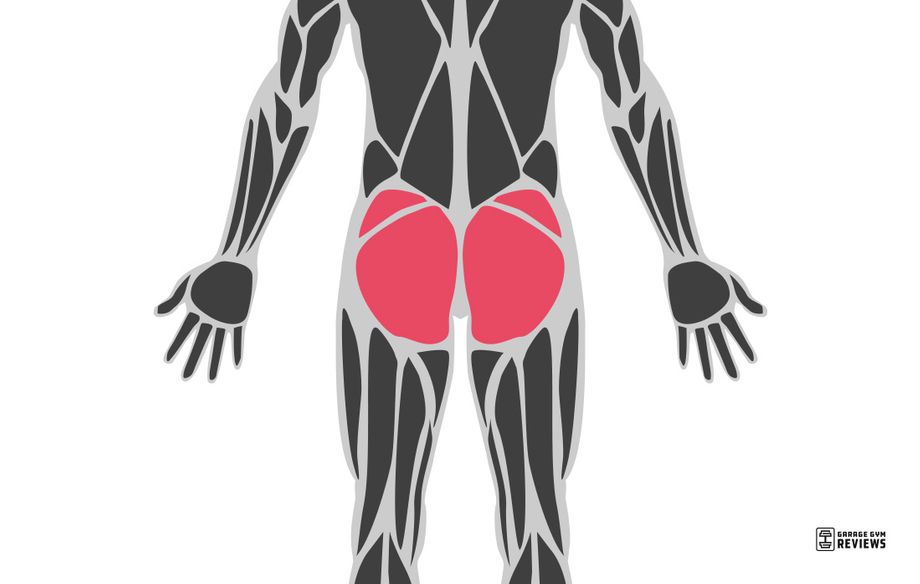
Core
When referring to the core here, we are talking about the obliques, rectus abdominis, and transverse abdominis (T.A.). The six-pack muscle and the T.A. stabilize the lower back to prevent excessive spinal extension and flexion and to allow the obliques to perform their rotational duties.
RELATED: Oblique Workouts
Wood Chop Variations
The dumbbell woodchop is excellent, but this movement can be performed with various tools. Here are a couple of examples below.
Standing Cable Wood Chop
The horizontal cable wood chop is less of a full-body move but focuses on the rotation of the upper body more. This fact makes it an excellent modification for beginners to the dumbbell woodchopper. The cable machine provides constant tension throughout the range of motion instead of the dumbbell.
How to do it:
- Set the cable pulley machine at just below shoulder height with a D handle attached.
- Stand with your side facing the weight stack and grip the D handle with your arms straight in front of you. Walk out laterally until you feel tension.
- Keeping your lower body still, twist away from the weight stack as far as your mobility allows.
- Return to the starting position and reset and repeat for desired repetitions.
- Repeat on the other side.
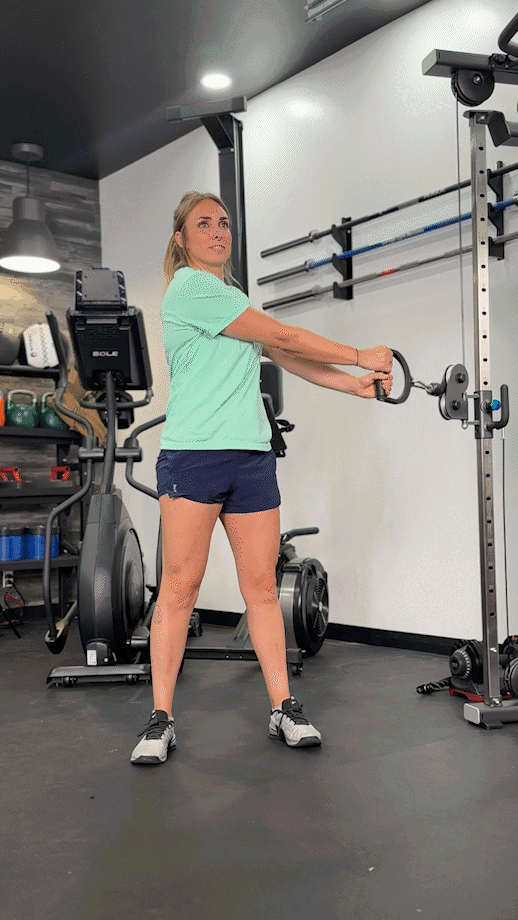
Seated Wood Chop
The seated wood chop is different from most wood chop variations, as the hips are not trained, and the obliques are preventing rotation, not initiating rotation; performing this variation is great for your posture and allows you to train the wood chop movement if back pain is an issue.
How to do it:
- Sit on the ground with your knees bent, heels on the ground, and your torso upright.
- Holding a dumbbell or medicine ball by your right hip, take it over your left shoulder while staying upright.
- Return to the starting position, pause, and repeat for reps.
- Then switch sides and repeat.
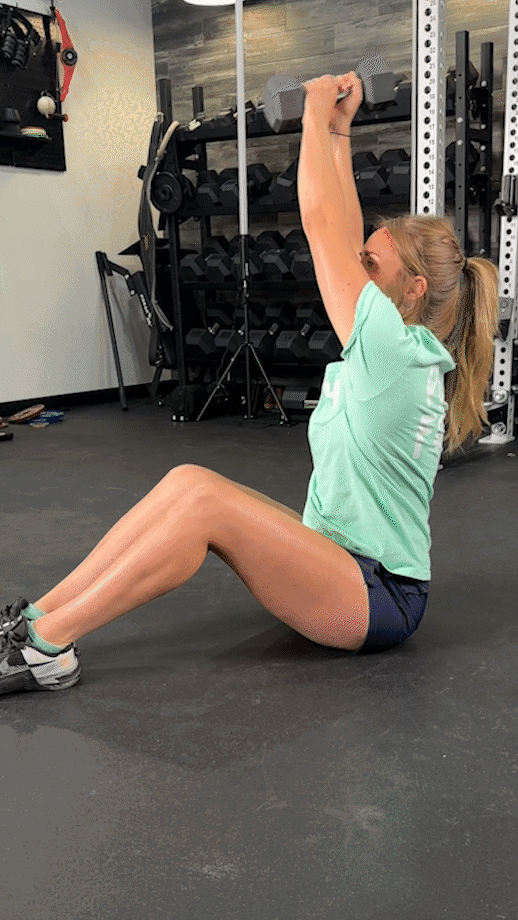
Wood Chop Lunge
The wood chop lunge trains the forward lunge with the wood chop movement to make the woodchopper more of a full-body dynamic exercise. This exercise will increase your heart rate and is excellent for inserting into any fat-loss HIIT circuit.
How to do it:
- Hold a light kettlebell or dumbbell over your right shoulder with your feet hip-width apart.
- Step into a forward lunge on the left leg while chopping the kettlebell to your left hip.
- Step back and return the kettlebell or dumbbell to the starting position and reset and repeat.
- Then switch sides and repeat for even repetitions.
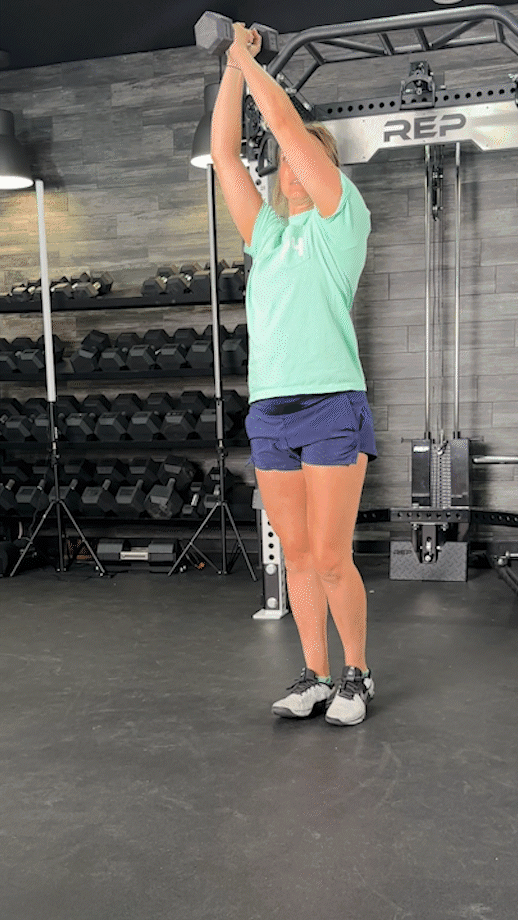
Resistance Band Wood Chop
The resistance band wood chop doesn’t involve hip internal or external rotation. Still, the band is easier on your upper body joints, and the ascending resistance strengthens your body where you are weaker for better core strength.
How to do it:
- Put a looped band underneath your right foot with your feet shoulder-width apart.
- Take an underhanded grip with your left hand and an overhand grip with your right hand with both arms straight.
- Bring the end of the band over your left shoulder, keeping your elbows locked and glutes and core engaged.
- Return to the starting position and reset and repeat
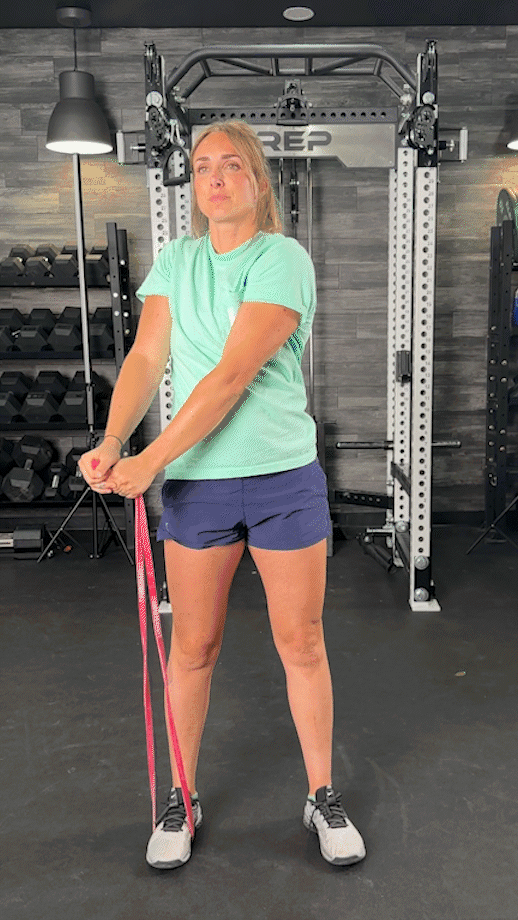
Half-Kneeling Kettlebell Wood Chop
You are taking the lower body out of it with the half-kneeling kettlebell wood chop, but you will improve hip mobility and glute isometric strength. If lower back pain is an issue, this is a great wood chop variation.
How to do it:
- Holding a light kettlebell in both hands, get into a half-kneeling position with your left knee below your hip and right ankle underneath your right knee.
- Take the kettlebell to the outside of your left hip and bring it across your body so it’s above your right shoulder.
- Return it to the outside of your left hip and repeat for reps.
- Then repeat on the opposite side for even repetitions.
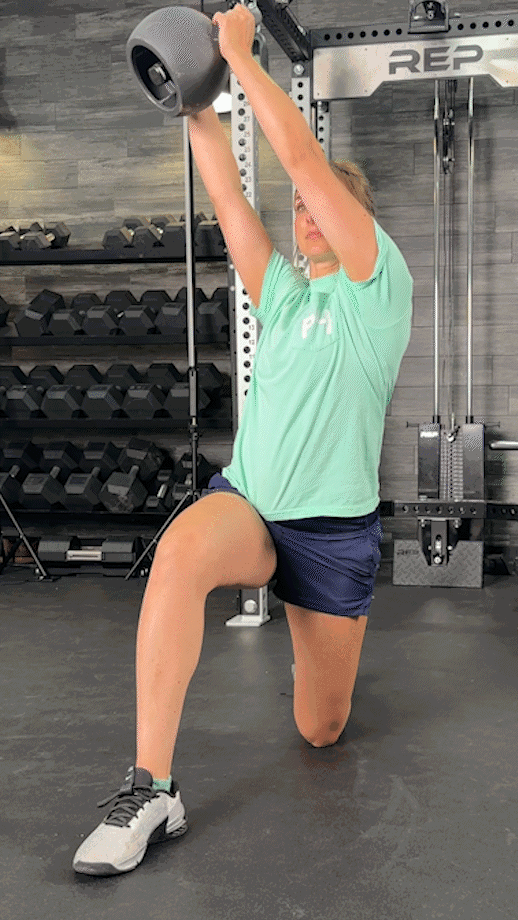
Common Mistakes
Avoid these common errors to get the most from the dumbbell wood chop exercise.
Too Much Bending of the Arms
Don’t bend your elbows too much while doing this exercise because this will shift the emphasis to your shoulder and arms and less to your abs and hips. Your arms should stay extended from start to finish.
Excessive Weight
The same argument could be made for all exercises because when you use more weight than you are capable of, it reduces the benefits of this exercise and increases your injury risk.
Wood Chop Exercise: Final Thoughts
The wood chop exercise and its variations are great exercises to improve rotational and anti-rotational core strength. When performed with proper form, doing the wood chop exercise regularly will:
- Improve sports performance
- Reduce your injury risk with rotational movements
- Train the core as a unit
- Work more muscle for better calorie burn
Your body is a 3D movement machine, so you should train like it. Happy rotating.
Wood Chop Exercise: Q&A
What is wood chop exercise good for?
The wood chop exercise improves your core muscles’ rotational and anti-rotational strength, especially your oblique muscles. If your sport or daily activities involve rotation, training the wood chop exercise is a great way to improve it.
What muscles does chopping wood use?
The wood chop exercise is a full-body movement that involves the muscle groups of the glutes, core, and shoulders.
How to do a proper wood chop exercise?
With most wood chop variations performing it properly involves rotating the hips and torso simultaneously with going across your body from a low to a high position or from a high to a low position.
References
- McGill, Stuart Ph.D., Core Training: Evidence Translating to Better Performance and Injury Prevention. Strength and Conditioning Journal 32(3):p 33-46, June 2010. | DOI: 10.1519/SSC.0b013e3181df4521
Further reading

After researching 14 Safety Squat Bars and testing 7 of them during training sessions featuring squats (regular, box, and front,) good mornings, lunges, JM Presses, and more, we think that the Titan Safety Squat Bar V2 is the best Safety Squat Bar for most people. Our previous pick was the EliteFTS SS Yoke Bar; although we still love the SS Yoke, version two of the Titan SSB is almost identical at a much lower price, especially when shipping is considered. It features heavy-duty steel, removable handles, thick padding, and chrome plating. There isn't a warranty which is unfortunate, but we doubt you'll ever need to use it. Read more

Our NordicTrack RW900 rower review details the new smart rower with remote-controlled resistance and iFIT integration. Read more

Wondering how to sell a used treadmill? We have a number of tips to help you score cash for your machine. Read more

The wood chop exercise is a weighted rotational movement performed with various equipment and angles. Your body is a three-dimensional machine, with rotation being one of those movements. The problem is many exercisers need to pay more attention to this movement and leave potential core strength gains on the table. RELATED: Best Core Exercises EquipmentBut after performing the wood chop exercise, you’ll also be a rotational machine with improved core strength and the ability to chop wood like a logger. » Read more about: Timber! Work Out Like a Lumberjack With the Wood Chop Exercise » Read more

